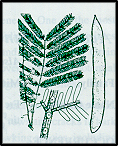South West Slopes Revegetation Guide
Acacia leucoclada
Northern Silver Wattle
Select from the following for detailed images.
Species Information
| Synonyms |
Racosperma leucocladum |
| Common Names |
Northern Silver Wattle |
| Family |
Mimosaceae - Mimosa family. |
| Name Origin |
From Greek leucos, white, and clados, young branch or shoot, referring to the whitish young shoots. |
Specimen Data -
| Location |
|
| Notes |
No Specimen Data Available |
| Collector |
|
Date |
01/09/1997 |
| Determined By |
|
Date |
01/09/1997 |
South West Slopes Revegetation Guide Information
| Regional: |
Noted in the areas: Lower Sandy, Yerong Creek and The Rock-Henty-Milbrulong. |
| Australia: |
Noted in the areas: Lower Sandy, Yerong Creek and The Rock-Henty-Milbrulong. |
| Habitat: |
Various soils, usually in sclerophyll communities. |
| Habit: |
Erect tree, 4-18 m high. Dark brown to black bark and silvery feathery foliage. |
| Similar Species: |
Distinguish from Silver Wattle (A. dealbata) by glands between pinnae pairs. Silver Wattle has glands at each pinnae pair. |
| Site Preference: |
|
| Characteristics: |
Fast-growing when young. |
| Flowering: |
Golden-yellow, Jul-Oct. |
| Seed Collection: |
Early summer, depending on season. Monitor closely, as seeds dropped soon after maturity. |
| Propagation: |
From scarified seed. Pour boiling water over seed and soak for several hours before sowing. |
| Regeneration: |
From seed or suckers, particularly after fire, ploughing or ripping. Often forms fire-induced thickets. |
| Timber: |
|
| Shade and Shelter: |
Useful fast-growing species for low to medium-level cover in windbreaks. Suckering ensures cover beyond the with slow growing eucalypts or other long-lived species in mixed woodlots. |
| Land Protection: |
Excellent for gully erosion control. Provides fast cover through its growth and suckering. Legume - improves soil fertility through 'fixing' nitrogen. |
| Wildlife: |
Excellent habitat. Attracts seed-eating birds including rosellas and cockatoos, and insect-eating birds including the Scrubwren. Many species of beetle and their larvae feed on foliage. Ants seek funicles (ovule or seed stalks) of fallen seed. Crimson Rosellas eat half-ripe seed pods. White-plumed Honeyeater sometimes nests in foliage. Critical habitat for gliders and possums, and gum a favoured food of the Sugar Glider and Squirrel Glider. Provides structural diversity for nesting and foraging. |
| Ornamental: |
Responds to water during dry periods. |
| Other: |
|
Note: The following information presented is only a guide, as plant characteristics vary depending on provenance (the plant's locality).
| Site/Preferred Habitat : |
creekbanks & lower slopes |
| Rainfall(mm) : |
400-900 |
| Growth Rate : |
fast (when young) |
| Tolerates : |
frost; drought |
| Resents : |
|
| Uses & Comments : |
Windbreak; erosion control; fixes nitrogen. |
Return to Database List
